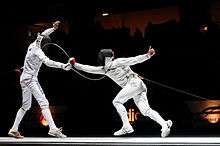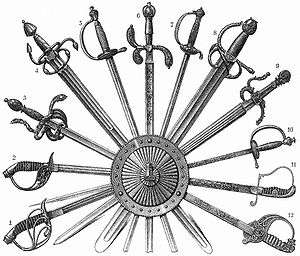Épée
The épée (English: /ˈɛpeɪ/ or /ˈeɪpeɪ/, French pronunciation: [epe]) is the largest and heaviest of the three weapons used in the sport of fencing. The modern épée derives from the 19th-century Épée de Combat,[1] a weapon which itself derives from the French small sword.[2]

As a thrusting weapon, the épée is similar to a foil (compared to a sabre, which is also designed for slashing) but has a stiffer blade, which is triangular in cross-section with a V-shaped groove called a fuller. It also has a larger bell guard and weighs more. The technique is somewhat different, as there are no rules regarding priority and right of way. In addition, the entire body is a valid target area.
Background

While modern sport fencing has three weapons—foil, épée, and sabre, each a separate event—épée is the only one in which the entire body is the valid target area (the others restricted to varying areas above the waist). Épée is the heaviest of the three modern fencing weapons. As with all fencing disciplines, fencing matches with the épée require a large amount of concentration, accuracy and speed. Since the entire body is a target, a successful épée fencer must be able to anticipate their opponent's moves and strike their opponent at the correct time.
In most higher-level competitions, a grounded metal piste is used to prevent floor hits from registering as touches. Unlike sabre and foil, in épée there are no right-of-way rules regarding attacks, other than the aforementioned rule regarding touches with only the point of the weapon. Touches are awarded solely on the basis of which fencer makes a touch first, according to the electronic scoring machines. Also, double-touches are allowed in épée, although the touches must occur within 40 milliseconds (1/25 of a second) of each other.
There is a special aspect to the épée that separates it from the other fencing weapons. This special aspect known to the majority of the épée community is the counterattack. Some specifications include the stop-thrust and the time thrust. These actions are a simple counterattack and a counterattack on the opposition, respectively. Said in plain words, it is a tactic employed in response to an attack. With the absence of right-of-way, following an attack and landing it correctly can be a highly efficient way to score a touch, thus the counterattack's ubiquity.
Description

A modern épée for use by adult fencers (size 5) has a blade that measures 90 cm from the guard to the tip. The total weight of the weapon ready for use is less than 770 g,[3] with most competition weapons being much lighter, weighing 300 to 450 g. Épées for use by children under 13 are shorter and lighter (size 2), making it easier for them to use.
The blade of an épée is triangular in section, whereas that of a foil is rectangular, and neither blade has a cutting edge. Wires may run down a groove in épée blades fitted for electric scoring, with a depressible button capping the point. In competitive fencing, the width of any of the three sides of an épée's blade is limited to 24 mm.[3]
The guard has numerous forms, but all are boiled down to a spherical shield, the section of which fits in a 10–13.5 cm cylinder.[4] This is frequently called a bell guard. As the hand is a valid target in competitive fencing, the guard is much larger and more protective than that of a foil, having a depth of 3–5.5 cm and a diameter of up to 13.5 cm.[3]
As with foils, the grip of an épée can be exchanged for another if it has a screw-on pommel. Grip options primarily include either the French grip and the pistol grip.
In competitions, a valid touch is scored if a fencer's weapon touches the opponent with enough force to depress the tip; by rule, this is a minimum force of 750 grams-force (7.4 N). The tip is wired to a connector in the guard, then to an electronic scoring device or "box". The guard, blade, and handle of the épée are all grounded to the scoring box to prevent hits to the weapon from registering as touches.

In the groove formed by the V-shaped blade, there are two thin wires leading from the far end of the blade to a connector in the guard. These wires are held in place with a strong glue. The amount of glue is kept to a minimum as in the unlikely (but possible) case that a fencer manages a touch in that glue, the touch would be registered on the electrical equipment, as the glue is not conductive (the blade is grounded). In the event of tip to tip hits, a point should not be awarded. A "body cord" with a three-pronged plug at each end is placed underneath the fencer's clothing and attached to the connector in the guard, then to a wire leading to the scoring box. The scoring box signals with lights (one for each fencer) and a tone each time the tip is depressed.
The tip of an electric épée, or the button, comprises several parts: the mushroom-shaped, movable pointe d'arrêt at the end; its housing or "barrel" which is threaded onto the blade; a contact spring; and a return spring. The tips are generally held in place by two small grub screws, which thread into the sides of the tip through elongated openings on either side of the barrel. The screws hold the tip within the barrel but are allowed to travel freely in the openings. While this is the most common system, screwless variations do exist. The return spring must allow the tip to support a force of 750 gf (7.4 N) without registering a touch. Finally, an épée tip must allow a shim of 1.5 mm to be inserted between the pointe d'arrêt and the barrel, and when a 0.5 mm shim is inserted and the tip depressed, it should not register a touch.[5] The contact spring is threaded in or out of the tip to adjust for this distance. These specifications are tested at the start of each bout during competitions. During competitions, fencers are required to have a minimum of two weapons and two body wires in case of failure or breakage.
Bouts with the different fencing weapons have a different tempo; like the foil, the tempo for an épée bout is rather slow with sudden bursts of speed.
History
Dueling sword
%2C_Graveur.-_Le_duel_%C3%A0_l'%C3%A9p%C3%A9e.png)
The French word épée ultimately derives from Latin spatha. The term épée was introduced into English in the 1880s for the sportive fencing weapon.
Like the foil (fleuret), the épée evolved from light civilian weapons such as the smallsword, which, since the late 17th century, had been the most commonly used dueling sword, replacing the rapier.
The dueling sword developed in the 19th century when, under pressure from the authorities, duels were more frequently fought until "first blood" (as indicated by the French to English translation) only, instead of to the death. Under this provision, it became sufficient to inflict a minor nick on the wrist or other exposed area on the opponent in order to win the duel. This resulted in emphasis on light touches to the arm and hand, while downplaying hits to the torso (chest, back, groin). Rapiers with full cup-guards had been made since the mid 17th century, but were not widespread before the 19th century.
Sport
Today, épée fencing somewhat resembles 19th century dueling. An épée fencer must hit the target with the tip of the weapon. A difference between épée and foil versus sabre is that a corps-à-corps or "body-to-body" contact between fencers is not necessarily an offense, unless it is done with "brutality or violence".
In the pre-electric era, épéeists used a point d'arrêt ("stopping point"), a three-pronged point with small protruding spikes, which would snag on the opponent's clothing or mask, helping the referee to see the hits. The spikes caused épée fencing to be a notoriously painful affair, and épéeists could be easily recognized by the tears in their jacket sleeves. A later evolution of the sport used a point that was dipped in a dye, which showed the location of touches on a white uniform; the dye was soluble in weak acid (e.g., acetic acid) to remove old marks.[6] Today, competition is done with electric weapons, where a circuit is closed when the touch is made. Non-electric weapons are now typically used only for practice, generally fitted with plastic buttons.
Modern épée fencing underwent a paradigm shift from classical fencing in the 1970s and 1980s. The shift was pioneered by Eric Sollee, fencing coach at MIT, and his student, Johan Harmenberg who subsequently won the World Fencing Championships and the Olympic gold medal. This new paradigm is based on the three Sollee Conjectures:
- Is it possible for the fencer with the lower technical ability to decide the technical level of a bout?
- Can the fencer with the shorter fencing distance control the distance in a bout?
- Is it possible to force your opponent into your own area of greatest strength? [7]
This new paradigm resulted in Johan Harmenberg closing the fencing distance, using absence of blade with destructive parries in order to not allow opponents to use their strongest moves, and pushing them into attacking high which was a prerequisite for Johan using his own strongest move. Harmenberg used this approach to win eight individual and/or team épée gold medals at Olympic, World Fencing Championships, and Fencing World Cup competitions. As a result, many if not most of the top fencers have used the new paradigm or at least adjusted to fence those who do.[8][9]
References
- Evangelista, Nick. The Encyclopedia of the Sword. Westport, Conn.: Greenwood Press, 1995. p 208
- Chisholm, Hugh, ed. (1911). . Encyclopædia Britannica. 9 (11th ed.). Cambridge University Press. pp. 667–669. This contains a detailed contempraneous description of the history and form of the sport.
- Book 3: Material Rules (PDF). Rules for Competitions. FIE International Fencing Federation. Dec 2018. pp. 15–21.
-
Les formes en sont assez nombreuses, mais toutes se ramenent a un segment de sphere dont la section couvrirait une surface arrondie de 10 a 14 centimetres de diametre; la profondeur est generalement de 3 a 5 centimetres.
— Claude dea Marche, 1989. Original source unknown, but accessible thus: https://www.benjaminarms.com/research/fencing-sword-specifications/french-epee-specifications/ - Garret, Maxwell R.; Kaidanov, Emmanuil G.; Pezza, Gil A. (1994). Foil, Saber, and Épée Fencing: Skills, Safety, Operations, and Responsibilities. Penn State University Press. p. 178. ISBN 0271010193. Retrieved 2012-11-26.
- Richard Cohen, By the Sword: A History of Gladiators, Musketeers, Samurai, Swashbucklers, and Olympic Champions, 2002, Random House, ISBN 978-0-375-50417-4; re-issued from Modern Library Paperbacks
- Épée 2.5: The New Paradigm Revised and Augmented, SKA SwordPlay Books, October 2014, ISBN 978-0985444181
- Epee 2.0: The New Fencing Paradigm, by Johan Harmenberg, SKA SwordPlay Books, October 2007, ISBN 978-0978902216
- Epee 2.5: The New Paradigm Revised and Augmented, SKA SwordPlay Books, October 2014, ISBN 978-0985444181
External links
| Look up épée in Wiktionary, the free dictionary. |
| Wikimedia Commons has media related to Épées. |

